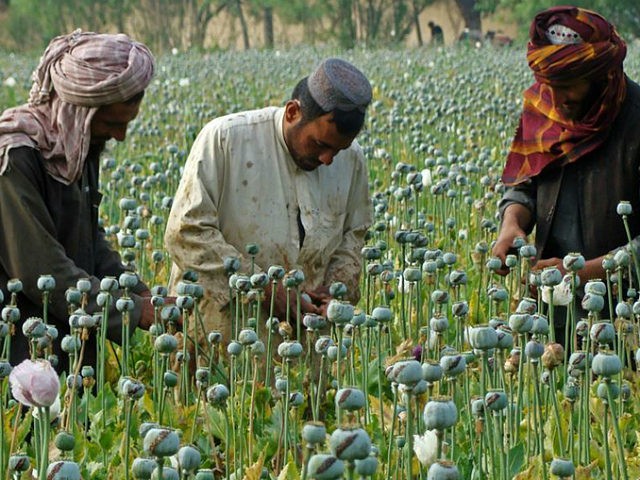Washington, DC — American taxpayer money has funded irrigation canals, farming equipment, and even fertilizer used to support the unprecedented poppy cultivation and heroin production in Afghanistan mainly benefiting Taliban narco-jihadists, U.S. officials found.
Afghanistan remains the world’s chief producer of opium, the main ingredient in heroin, despite the more than $8 billion the United States has invested on counternarcotics activities in the country since the start of the war in October 2001.
Opium cultivation and production, which reached unprecedented proportions last year, chiefly benefits the Taliban terrorists, providing them with an estimated 60 percent of its funding, valued at nearly $200 million, according to U.S. officials.
On Wednesday, Alice Wells, the principal deputy assistant secretary for the U.S. Department of State’s Bureau of South and Central Asian Affairs, told the House Foreign Affairs Committee, “The narcotics we assess account for about 60 percent of the Taliban budget. … Eighty-five percent of opium is grown in areas that are controlled or contested by the Taliban.”
Her comments came about a week after the U.S. Inspector General for Afghanistan Reconstruction (SIGAR), a watchdog agency, revealed in a report that U.S.-funded alternative development projects (ADP) are being used to support poppy cultivation in Afghanistan.
Between 2005 and 2008, the U.S. Agency for International Development (USAID) devoted at least $330 million in funding to failed ADP projects intended to deter farmers and traffickers from cultivating and trafficking opium.
John Sopko, the chief at SIGAR, learned that the agricultural development programs — namely those used to rehabilitate canals that have rendered an area more than three times the size of Washington, DC, fertile— have “inadvertently” fueled the cultivation of the poppy crop.
Last Thursday, SIGAR reported:
In some areas, development programs inadvertently supported poppy production. One example of this was the rehabilitation and development of irrigation systems. USAID reported that ADP East and South rehabilitated canals that increased the productivity of 113,808 hectares of land.
…
Geospatial data derived from satellite imagery shows that, in some areas, the [USAID’s Kandahar Food Zone program] KFZ’s focus on irrigation facilitated an increase in the amount of land dedicated to agriculture under the improved canal systems, but also contributed to rising levels of opium poppy cultivation.
SIGAR also learned that some USAID projects based provided resources for farm equipment and fertilizer used to cultivate opium.
Wells, the top State official, told lawmakers the U.S. military is currently focused on targeting Taliban-linked opium traffickers in heroin labs, not the farmers and the crops.
She explained that the Afghan government is not interested in crop eradication right now, so the American military is going after the heroin labs instead.
Marking a departure from his predecessors, U.S. President Donald Trump authorized the American military to target opium and heroin drug labs with airstrikes.
“We are limited right now because of the security situation and where the opium is grown … rather than undertake eradication, which is not supported by the Afghan government at this stage, you know, the effort is to go the step up and … through the drug labs, through targeting of the drug networks to get to that level of individuals who are benefitting more, and who are a greater part of the drug trade,” Wells said, referring to the Taliban.
“There have been some successes. Rather than going after individual farmers, we’ve focused on drug labs. Last year, we had 84 joint raids. We interdicted about $360 million worth of drugs,” she added. “There’s now a Counter Narcotics Justice Center, which is prosecuting these narcotics cases. They have a 99 percent conviction record.”
SIGAR has questioned the effectiveness of the air campaign against the drug labs.
Last year, the historic production of opium and its heroin derivative had a record output value of up to $6.6 billion — nearly a third of Afghanistan’s entire gross domestic product — that supported “up to 590,000 full-time jobs, a number substantially higher than the entire strength of the Afghan army and police forces,” Sopko declared.
Rep. Dana Rohrabacher (R-CA), a long-time critic of America’s counternarcotics operations in Afghanistan, urged the Trump administration to target the poppy crop.
“If we wanted to eliminate the poppy production in Afghanistan, we could do it within a week,” he declared during Wednesday’s hearing.
In the past, the Republican lawmaker suggested aerial spraying to destroy the opium crops, a method that has been prohibited by the U.S. Congress since 2009 due to the environmental impact of herbicides.
Former President U.S. Barack Obama’s administration ended the U.S.-led eradication efforts in Afghanistan.

COMMENTS
Please let us know if you're having issues with commenting.